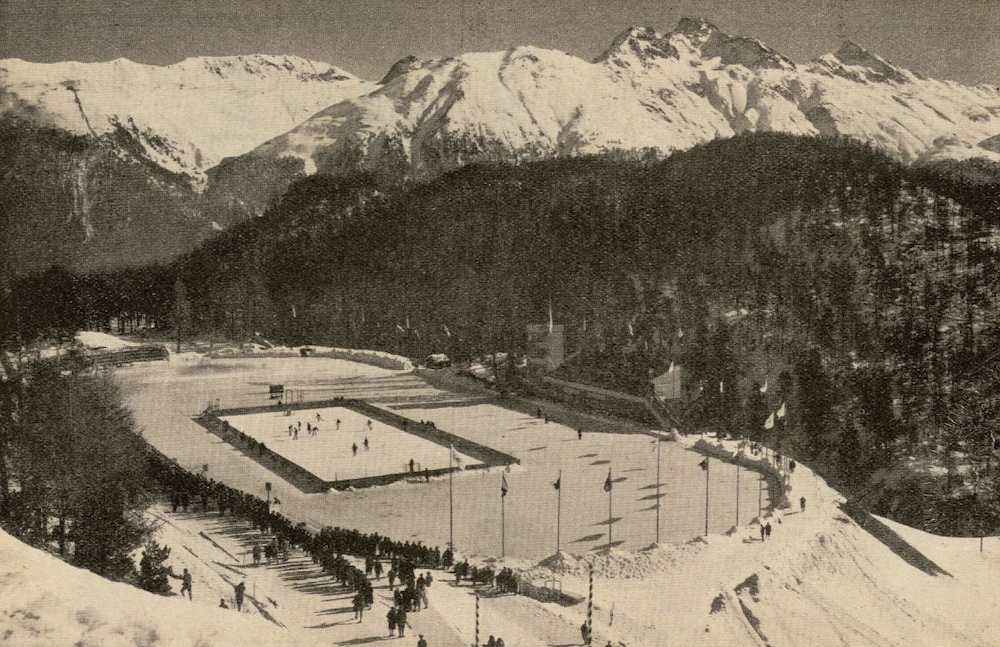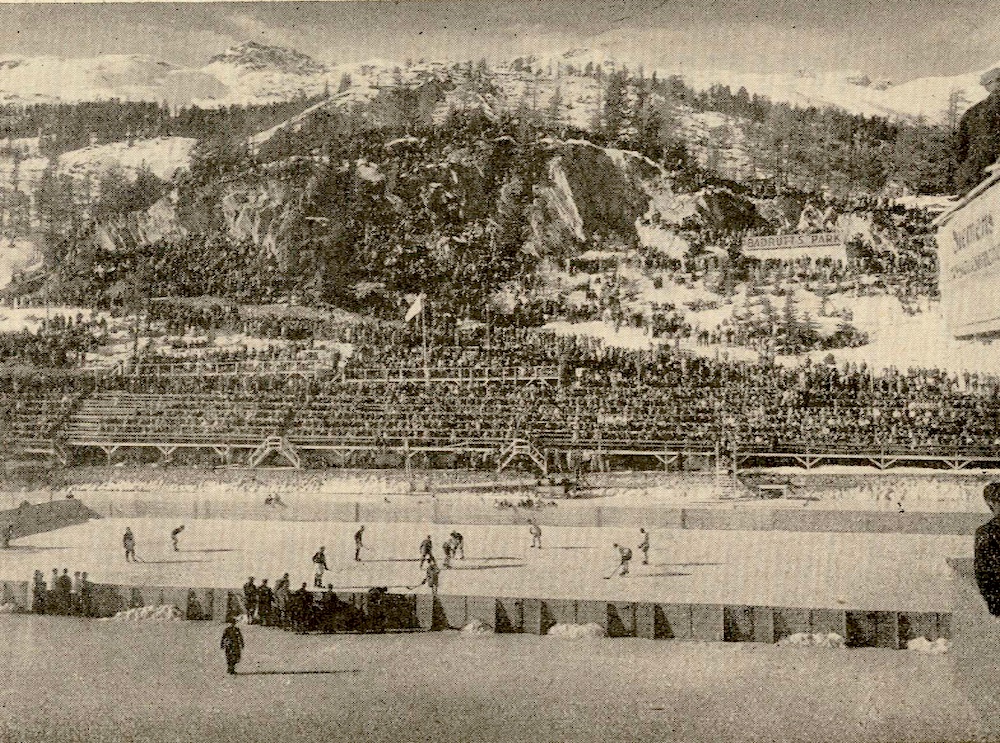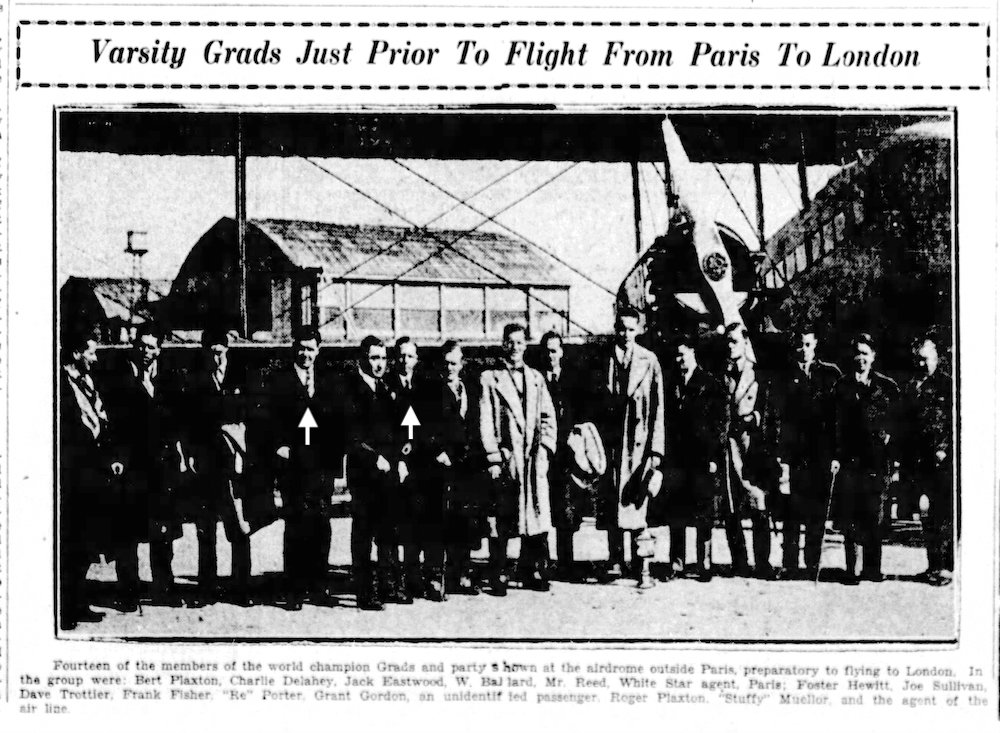On this date in history, March 21, 1928, Toronto newspapers were filled with stories and photographs welcoming home the Varsity Grads from Europe. Canada’s representatives in hockey at the 1928 St. Mortiz Winter Olympics had returned to the city the previous day (March 20 was a Tuesday ninety-five years ago) after a successful European tour and had been paraded from Union Station (on Front Street) to City Hall (now Old City Hall) at Bay and Queen in downtown Toronto.
As the name implies, Canada’s gold medal-winning hockey team was made up mainly of graduates of the University of Toronto. The Varsity team had reached the finals of the Allan Cup, Canada’s national senior amateur championship, in 1925 and 1926, only to be defeated by the Port Arthur Bearcats in both seasons. Returning to the final as the Varsity Grads in 1927, they defeated the Fort William Forts in a tight series in Vancouver to earn the right to represent Canada at the 1928 Winter Olympics.

on March 21, 1928. The bottom is from the Sault Ste. Marie Star on March 28.
To prepare for their European journey, the Varsity Grads withdrew from competition in the Ontario Hockey Association for the 1927-28 season. From November 26, 1927, through January 21, 1928, the Grads played a series exhibition games before departing for Europe from Halifax on January 22, 1928. If I counted right, a total of 14 games were scheduled, although one was never played. Of the games they did play, most resulted in one-sided romps. Among the very few close games, the Grads defeated the University Club of Boston 2-1 in Boston on January 6, 1928 and suffered their only loss when they were beaten 1-0 in a rematch two nights later.
After playing their final home game in Toronto on January 17, 1928 (either a 10-2 or 12-2 victory playing one period against each of three different Toronto teams at Varsity Arena), the Grads played in Kingston, Montreal, and Halifax on January 18, 19, and 21 and then sailed for France.

The Grads had a rough crossing before arriving in Cherbourg, on Sunday, January 29 after six days and 18 hours at sea. They had traveled with the figure skaters, speed skaters, and skiers who would also be representing Canada at the Olympics. All athletes made their way to Antwerp the following day, but while the other competitors left the Belgian town immediately for St. Moritz, the hockey team stayed in Antwerp a while longer. They had their first workout on Olympic ice on February 6. The hockey tournament began on February 11, 1928.
The United States didn’t send a hockey team to Switzerland for the 1928 Winter Olympics, and so the decision was made to split the 10 European countries into three round-robin groups, with the winners of each advancing to the final round to play off with Canada, who had been given a bye. After nearly a month without any games, Canada then played three times on three straight days, but it didn’t matter. The Grads defeated Sweden 11-0 on February 17, Great Britain 14-0 on February 18, and then Switzerland 13-0 on February 19 to win the gold medal.

After the 1928 Winter Olympics closed on February 19, the Grads embarked on a European tour. They defeated the Austrian Olympic team 13-0 in Vienna on February 22, and then traveled to Berlin where they defeated Germany 12-2 and Switzerland 12-1 on February 25 and 26. The game with Switzerland may have been played in Davos, although some newspapers report the scores as 13-2 and 12-0, and also list a 6-0 score at a different game in Davos, so it’s a little unclear.
The Canadians finally had some real competition in Berlin on February 27 … when the Olympic starters played their own backups and scored a 5-4 victory. Some members of the team then flew from Berlin to Paris, where they beat a Paris team 6-0 on March 2. Next, the team flew to London, where they defeated an English team 11-4 on March 8. The Grads were to be presented to the Prince of Wales (the future King Edward VIII, briefly) the following day — although it appears he abdicated on them too! He is said to have sent a telegram congratulating the team on its gold medal victory and expressing regret that he would not be able to entertain them in person (as he had with the Toronto Granites following their Olympic championship in 1924).

On March 10, 1928, the Varsity Grads sailed for home from Liverpool. They arrived in Halifax on March 17, and then played a final exhibition game either that night or the next. After defeating the Moncton Atlantics 6-1, they boarded a train home for Toronto. Delayed 14 hours by snow in New Brunswick, they arrived in Montreal some time between midnight and 2 am in the early morning of March 20. Still, they were able to find food and drink in the city before returning to their train car to sleep until late morning when they departed for Toronto.
Scheduled to arrive at Union Station at 5:40 in the afternoon, the players were greeted at the train platform by family and friends who hadn’t seen them in two months. “But,” as the Toronto Star reported, “at every step towards the exits they became more and more public property.”

Greeted at the end of the “underground station labyrinth” by representatives of the city and their university, they then stepped out into a huge traffic jam on Front Street. Loaded into cars, they were led by horses, motorcycles, and marching bands to City Hall, where the Mayor of Toronto, Sam McBride, made a welcoming speech. Each player was presented with a diamond stickpin before addressing the crowd themselves. And for those who couldn’t make it out to see the players in person, the whole thing was broadcast on the radio.
As usual, good story telling Eric. I often think the biggest challenge to the Grads would have come from little known Augsburg College which had five Hanson brothers on the roster. Two of the Hansons did well in pro hockey . But General MacArthur, as you probably know, scuttled the plans of the Augsburg boys by cancelling the U.S. team’s participation and perhaps costing the U.S. a silver medal.
So, Foster was there with his parents but did not do any broadcasting.
Interesting.
Yes, it definitely would have been a bigger challenge for the Grads if the Americans had a hockey team there.
And, no, it does not appear that Foster broadcast any games from Europe. (Until 1955, when he went to the World Championship to cover Penticton vs. the USSR.)
In my story from last month about the early radio broadcasts, I found that Toronto Star article saying that Norman Albert was calling games in early 1928 due to Foster’s absence. I wondered where Foster might have been, and came across that airplane photo. I also found other stories from January of 1928 when the Grads and other Olympic athletes sailed for Europe. Some (but not all) mention Foster Hewitt travelling in addition to W.A. Hewitt and his wife (Foster’s mom).
Fascinating to learn of the hockey championship at UofT. My older brother, now almost 96, living in Israel, graduated in 1948 in Engineering. The youngest student, and probably the only Jewish student. He was not into playing sports, but until he made Aliyah, he and my younger brother, followed the Toronto Maple Leafs very closely, listening intently to the Saturday night games. Never thought of the UofT as a sports university, although many a Jarvis sports person excelled on the Blues teams. With those crowds in the photos, can you image if the Leafs manage to win the Stanley Cup!! I am not holding my breath. Love to read your work. All the best!!
University sports were very big in Canada once upon a time. The U of T is probably better known for football back then, but had some good hockey teams too. And Bruce Kidd running track. Amanda used to take gymnastics in the U of T gym, and they have some pretty interesting old sports items on display in the main lobby. (Or, they used to, anyway … this was a while ago!)
Thanks, Eric. I never fail to learn something from your articles, and the note on Harold Ballard and the tube skates is another example. I had no idea about that facet of his life. Well done!
Imagine the parade when the Leafs win the Cup! You have to imagine it because it may never come to be!!
Hockey was played for the joy of it then. Not for millions $$$
And most of the boys were humble.
But today, at least on paper if not for real, non-White men, even gays, could, in theory, play in the NHL. But wearing a rainbow jersey? Still a ways off.
Great nostalgia, as always written with passion.
Keep on telling us the history of the religion of Canada…..which is Hockey!
Another fascinating story, Eric and lots of good transportation stories in your article. Another part of the story that Brian McFarlane noted. Michigan Tech coach Carlos Haug wrote that since Tech won the 1927 Midwestern Intercollegiate championship, his team should be considered. MacArthur, chairman of the U.S. Olympic Committee, developed a playoff and approached the University of Minnesota, and teams from Chicago and Boston, but they all declined. He then approached Harvard, Eveleth Junior College, and Augsburg. William Haddock, chairman of the U.S. Olympic Hockey Committee, selected Augsburg as they were undefeated in 1927 and the early part of 1928. MacArthur then decided not to enter a team as he felt that “Augsburg was not representative of American hockey.” It is the only time that the U.S. has not competed in the Olympic ice hockey tournament. Haug was disappointed as he tried all season to schedule games with Augsburg and Eveleth Junior College but the arrangements could not be finalized.
Thanks, Bill. A lot more information than I knew regarding the 1928 U.S. Olympic hockey situation.
Another great piece, Eric. In a related matter, back in 2014 I published a piece entitled
“En route to St. Moritz Gold, Boston’s University Club Steals One From The Toronto Grads.” While a bit peripheral to your narrative I thought you might find it of interest. I’ll forward it shortly.
Good to read your article,Eric!
Hope all is well.
My Native American uncle, Clarence “Taffy” Abel won a Silver Medal for Team USA in the 1924 Winter Olympics. He was the First Native American in the Winter Olympics.
He as the First Native American Flag Bearer in the 1924 Games on January 25, 1924. January 25, 2024 is the 100th Anniversary of such. Here’s a great photo:https://shorturl.at/hluv4
Taffy Abel was also the First Native American/Indigenous Hockey Player in the NHL on November 16 1926 with the New York Rangers and broke the NHL Color Barrier that day.
However, Gary Bettman refuses to honor him. More at http://www.TaffyAbel.com
This would be an excellent long form story for Eric.